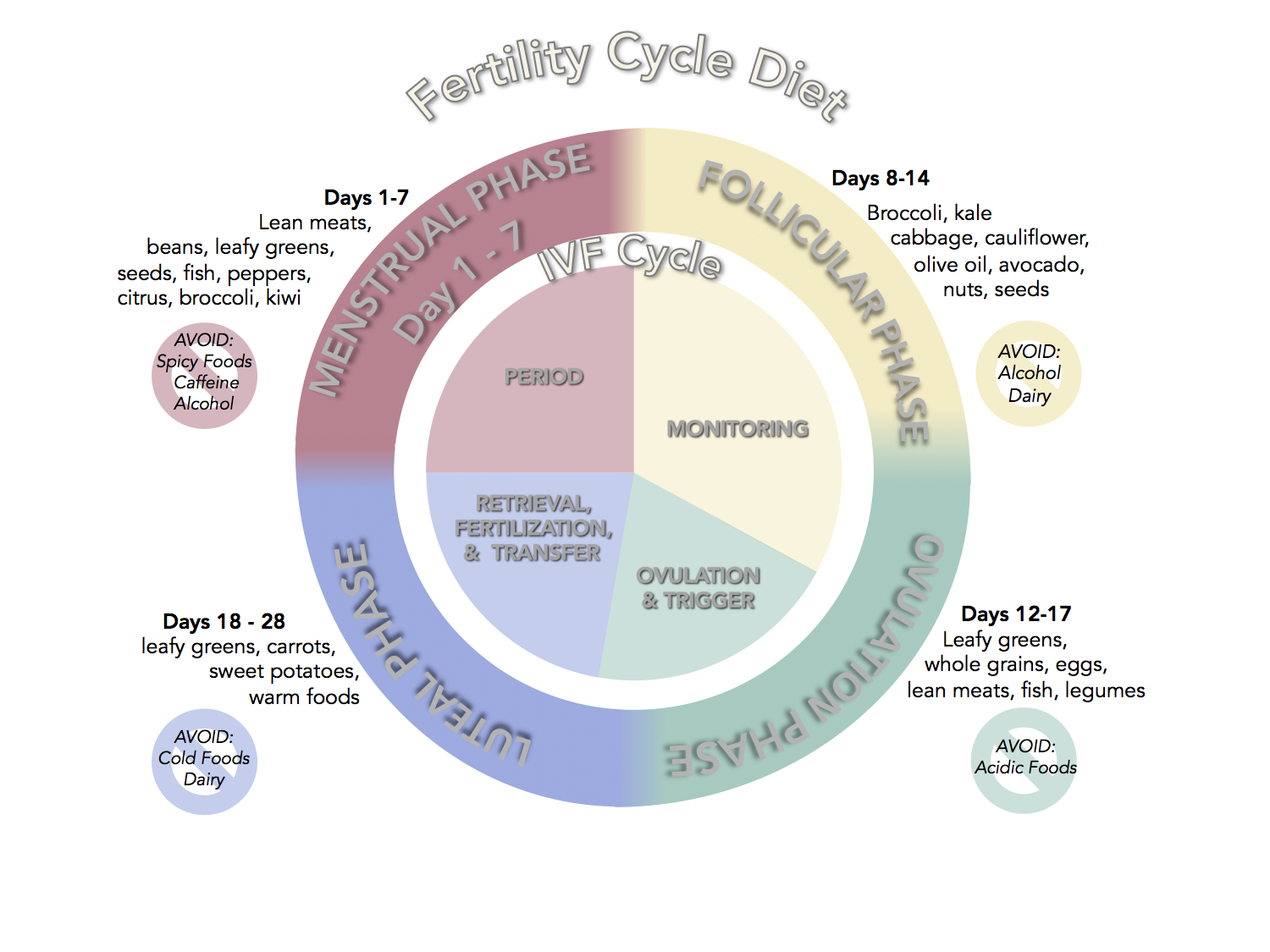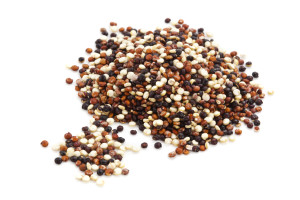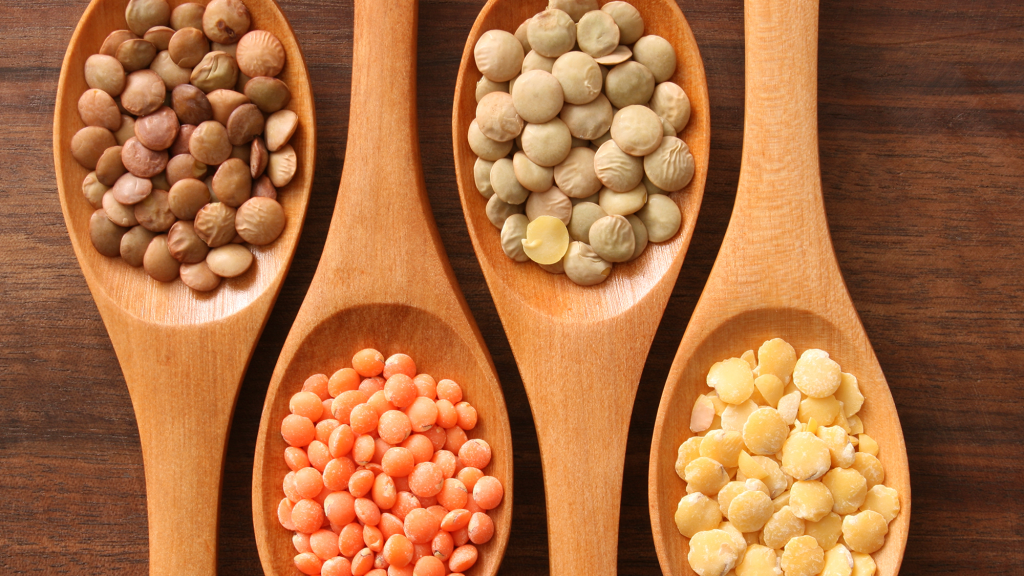Eating a fertility diet in preparation for pregnancy and to boost fertility is one of the most powerful health changes you can make. Numerous studies have shown that specific changes in the diet can increase the chances of healthy ovulation, prevent recurrent miscarriage and support a healthy pregnancy.
Nutrition plays a big role when it comes to having a healthy body and reproductive system. The building blocks for hormones are found in the foods we eat. Antioxidants that help to protect the egg and sperm from free radicals are found in the foods that we eat. Just as nutrients in food can be helpful for fertility, there are some foods and chemicals added to foods that can be harmful to your health and fertility. Please remember to avoid environmental toxins and eat fertility-friendly diet. “Food and Fertility, Does it Matter?” – the great article for you to read!
Fertility Phase Diet
Foods to Avoid, Reduce or Eliminate
Lifestyle Changes
Breakfast Recipes
Fertility Phase Diet

Menstrual Phase
Lean meats: Protein can help your blood sugar remain stable, which will offset your cravings. Lean meats, such as extra-lean beef and skinless white-meat poultry, provide rich amounts of heme iron – the type most easily absorbed by the body.
Beans: The high fiber content of beans and peas reduces the congestive symptoms of cramps by producing bulkier stools with higher water content, ridding the body of excess fluid, and also normalizing digestion. Legumes are also a good source of B vitamins, which prevent cramps and menstrual fatigue. Beans can create excess gas, so try adding peppermint tea to your diet.
Leafy Greens: High in folate (a B vitamin), which helps manufacture blood cells to replace what you are losing. Folate has also been shown to improve ovulation so load up now! Leafy greens are also high in calcium and vitamin D, which, together, can help ward off PMS symptoms.
Seeds: Pomegranate is the best. Pumpkin seeds, with high levels of magnesium, can help alleviate PMS symptoms like water retention and mood swings since magnesium helps regulate serotonin levels. Additionally, both pumpkin and flax seeds are also estrogen boosters.
Fish: Because of the high levels of Omega 3 Fatty Acids, fish (such as salmon) can treat PMS symptoms. Omega 3s decrease inflammation, and clearly, there is inflammation during menstruation. Steer clear of Omega 6 (another important essential fat found primarily in plant oils, such as canola, soybean, and corn oils)for this stage of the cycle, because while Omega 3 decreases inflammation, omega-6 can increase inflammation.
Citrus: Fruits are an excellent form of natural anti-inflammatory substances like bioflavonoids and vitamin C. These nutrients not only help strengthen the blood vessels but also reduce menstrual cramps thanks to their anti-inflammatory effects.
Broccoli: This green vegetable has a high fiber content that can actually ease bloating. Broccoli contains calcium, vitamins A, C, B6, and E, potassium, and magnesium — nutrients that help alleviate PMS symptoms.
Beet: Beets are a great source of iron and minerals, and can help nourish our blood during all phases of the cycle, but are particularly important during the menstrual and luteal phases.
Dried fruit: Apricots and raisins are great snacks, as well as being good sources of iron. They also contain manganese (magnesium), which can alleviate cramping and has also been shown to help reduce heavy flow.
Choline: Many women have COMT SNPs methylation issues which affect infertility as well as MTHFR gene mutation. You can take supplement versions of choline but you can take from foods. Here is the Choline Database you may check out which foods contain choline or not.
AVOID:
spicy foods, caffeine, and alcohol: can increase bleeding and inflammation
salty food: can increase bloating
Follicular Phase
Cruciferous Vegetables: As estrogen levels rise during the follicular phase, it brings back physical and mental energy levels. Broccoli, kale, cabbage, cauliflower, contain a phytonutrient called diindolylmethane (DIM), which can help women metabolize estrogen better.
Leafy Greens: Dark leafy greens such as kale, swiss chard, and spinach, help to replenish minerals you may have lost during your period. They are also high in folate, a B vitamin that has been shown to improve upcoming ovulation.
Olive Oil: High in vitamin E (or L-arginine), which has been shown to improve follicular development. Vitamin E is found in the fluid of the follicle that’s housing your egg.
Avocado: Also loaded with vitamin E, avocados are an excellent source of folate.
Nuts & Seeds: Do not forget to eat Pomegranate! Continue eating flax and pumpkin seeds! They provide the body with omega-3 fatty acids which promote healthy cell membranes, allowing hormones to do their jobs in the body. Additionally, pumpkin seeds are high in zinc which supports progesterone, and flax seeds reduce excess estrogen. The combination of pumpkin and flax seeds helps balance estrogen production and absorption in the body.
AVOID:
Alcohol
Dairy
Ovulation Phase
Water: Water plays a vital role in transporting hormones and developing follicles. It also helps thin out cervical mucus, if you are trying to conceive naturally.
Leafy Greens: Keep eating those greens! Their B vitamins have been shown to improve ovulation. Plus, leafy greens can also naturally increase your libido by providing high levels of iron.
Beans: Lean protein and full of iron, beans help to increase fertility and libido. Low iron levels can result in anovulation, which is when ovulation does not produce a healthy egg.
Whole Grains: Whole grains are packed with nutrients such as iron, selenium, and magnesium. They’re also especially good sources of the B vitamins (including B1, B2, folic acid, and niacin).
Eggs: Eggs contain not only protein and Omega 3s but iron, selenium, magnesium, B vitamins, vitamins A, C, D, and Zinc. Be sure to be eating the best eggs possible – organic, pasture-raised. The more orange the egg yolk is, the more vitamin A and D it contains.
Lean Meats: All these protein sources are chock-full of iron — an essential nutrient that helps beef up fertility. In fact, studies show that women who pump up their iron intake during the preconception period have a higher fertility rate than women who are iron-deficient.
Fish: Fish is low in saturated fat and high in protein, vitamin D, and fish oil thins out your blood, increasing circulation to your body parts. Be cautious of mercury levels in fish – stick to 12 ounces per week, and avoid shark, swordfish, king mackerel, and tilefish entirely. Plus, fish oil boosts the testosterone in your body—yes, women have this hormone too—so you may become aroused more quickly.
Baby Carrots: These favorite snack veggies are often touted for maximizing your body’s baby making juices because they’re alkaline (the opposite of acidic), making for a more welcoming place for sperm.
Choline: Many women have COMT SNPs methylation issue which affects on infertility as well as MTHFR gene mutation. You can take supplement version of choline but you can take from foods. Here is the Choline Database you may check it out which foods contains choline or not.
AVOID
Acidic Foods: coffee, alcohol, meat and processed foods, which may make your cervical mucus hostile to sperm.
Luteal Phase
Leafy Greens: Yes, here they are again! Dark leaves are amazing sources of B vitamins, which are important for balancing your hormones in your luteal phase and to nourish a healthy uterine lining. Greens like kale, collard or beet greens promote healthy estrogen metabolism and digestion, so make sure to have a green salad or cooked greens every day during your luteal phase. They also contain calcium, magnesium, and folate, which are crucial for keeping cramps and headaches at bay. Experiment with salads during the dreaded “Two Week Wait!”
Carrots: The beta-carotene rich carrot helps keep your hormones in check and can help prevent early miscarriage. Beta carotene-rich foods are an important ingredient to include in your diet during this time. The corpus luteum (the ruptured ovarian follicle that produces progesterone to thicken the womb lining, close the cervix and maintain a pregnancy) contains a high level of beta carotene, so supporting This nutrient is a powerful antioxidant that helps protect your cells from damage.
Sweet Potatoes: The carbohydrates in sweet potatoes boost serotonin, a shortage of which can cause mood swings! Sweet potatoes have also been shown to raise progesterone levels, which gives a fertilized egg a better chance of implantation.
Pineapple: You may have heard stories about pineapple and increased implantation? In addition to beta-carotene, pineapple contains a substance called bromelain, which has been shown to support implantation through its anti-inflammatory properties mildly. Bromelain is also a natural blood thinner (like a baby aspirin), which encourages blood flow to the uterus, helping implantation and reducing the chances of miscarriage. However, consuming too much bromelain too early in your cycle may be prohibitive to conception, so be sure to avoid it during the Follicular and Ovulation phases.
Onion: Onions cleanse the liver, kidneys, and blood. Sulfur-rich foods like garlic and onions can help to detoxify heavy metals from the body. Onions can fight insulin resistance, which is especially important for women with PCOS.
Seeds: Sunflower and sesame seeds are important for progesterone balance during the second half of the cycle. Sesame seeds have a high zinc and selenium content, and sunflower seeds encourage the body to make progesterone. The lignans in sesame seeds balance excess estrogen production. Again, the superfood – Pomegranate!
Citrus: Vitamin C can help balance hormones and improve pregnancy rates. Studies have also shown that is necessary to not only ensure healthy sperm but to support them in getting where they need to go. High levels of vitamin C can also be found in red, orange, and yellow peppers.
Berries: Packed with antioxidants, these members of the berry family protect your body from cell damage and cell aging — and this includes cells in your reproductive system (aka your eggs).
Hot Peppers: Peppers can help improve blood circulation in the body.
Warm Foods: Ditch the ice cream for now! As progesterone levels rise, so does your temperature, and a warm womb is an inviting womb. The luteal phase is all about creating higher temperatures to help hold a pregnancy, so eat foods that support warmth. Stock up on soups and stews, or add some warming herbs to foods such as cayenne, ginger, cinnamon.
Choline: Many women have COMT SNPs methylation issues which affect infertility as well as MTHFR gene mutation. You can take supplement versions of choline but you can take from foods. Here is the Choline Database you may check out which foods contain choline or not.
AVOID
Cold Food: Especially ice cream and frozen yogurt. The luteal phase is a time when you want to promote growth and expansion; cold constricts.
Dairy: Can increase cervical mucous
Foods to Avoid, Reduce or Eliminate
Foods to Avoid |
Foods to Reduce |
Foods to Eliminate |
| Avoid eating foods that create mucus – corn, corn oil, milk, cottage cheese, yogurt, syrup, jams and jellies, ice cream cookies, butter, cereals, pies ghee, chips, bread, pretzels, deep-fried foods, cake, soy products, safflower oil, sunflower oil (Tamie’s Tip – Eat foods that ELIMINATE mucus – cauliflower, garlic, celery, asparagus, bamboo shoots, onions, lemons, limes, grapefruit, green vegetables, ginger, oranges, pineapple) | Reduce simple carbohydrates and sugar intake. These two are the silent killers and the major contributors to all kinds of inflammation in the body. Eliminate completely if you can, and after 4–6weeks, you won’t miss it. You will start to feel so much better! More energy because your blood sugar level is no longer spiking and crashing, the good bacteria in your guts start to grow, and your immunity gets stronger. Your cravings will diminish because your sleep quality is improved – more growth hormone is made – and the more fertile you become! | Remember Top 10 Toxic foods – caffeine, soft drinks, bacon, milk, fast food, corn, margarine canola oil (Tamie’s Tip – Top 10 Detoxing Foods – kale, onions, garlic, blueberries, strawberries, carrots, cabbage, collard greens, broccoli, and watercress.) |
| Avoid food that causes inflammation – gluten casein (in bread, baked goods), safflower, sunflower soy and corn oil, meat, dairy, processed meats, fried food, syrup, and soft drink, fast foods (Tamie’s Tip – Eat foods that ELIMINATE inflammation – nuts, avocado, spinach, turmeric and ginger, olive-oil, tart cherries, pineapple, orange-colored vegetables and fruits, onions and garlic) | Reduce your coffee intake – the good site for you to read. Here’s Teeccino – herbal coffee alternative choice! | Stop eating SOY-based foods! If you like to eat Tofu, buy Non-GMO tofu at Whole Foods. Interesting article about Kashi Cereal |
| Avoid using the following oils for cooking: Margarines & spreads, Crisco shortening, Canola oil, Cottonseed oil, Peanut oil, Corn oil, Soybean oil, Grapeseed oil, Safflower oil, Sunflower oil, Palm oil | Margarine is not food! It is a chemical substance.
***Avoid using Safflower Oil*** |
|
| Avoid “Trans Fat-partially hydrogenated oil”. Trans Fat + Sugar + Dairy Products + Meat (Organic is fine) => mess up your body in cellular level => not good news for reproductive organs | ||
| Avoid drinking citrus juice (example: orange juice) when the temperature is 60F. It increases mucus production in the guts. | ||
| Avoid wheat and gluten. Gluten sensitivity and infertility are shown to have a link. Why do we need to avoid eating wheat? Here is a great article that explains why. |
Lifestyle Changes <Avoid List>
-
- Avoid exercises like swimming, hot yoga, power yoga, spinning class, kickboxing, running during the IUI and IVF cycle. I recommend you to do pelvic stretching yoga, pilates, and a quick walk.
-
- Avoid going to shopping malls, markets (wear gloves), airports, and movie theaters. Especially during the winter season. I have seen patients get stomach flu, bad colds, and flu. They had to cancel their cycle.
-
- Avoid using Tooth Paste that contains fluoride. Here are my picks:
-
- Are you using water filter “fluoride” as well?
- Avoid these toxic chemicals – PFOA, PFOS, Benzene, BPA, and Phthalates
-
- Try NOT to fill your calendar. You will be busy with blood tests and ultrasound (and acupuncture) etc… Stress is the #1 infertility cause. Try to keep your weekday evenings and weekends open.
-
- Avoid the Top 5 “Anti-Nutrients” – Soy (fermented Soy is no harm but actually good), GMOs, Pesticides, herbicides, hormones, Sugar, Plastic Water Bottles Read more here.
-
- Avoid eating Peanuts that are high in mold content. Here is a good alternative->Homemade Creamy Almond and Date Butter (Peanuts Alternative)
- Avoid Hair Coloring products that contain strong chemicals. Recommendations for Natural Hair Coloring:
-
- Naturtint – No ammonia, no resorcinol, no parabens
- Herbatint– Better grey coverage
-
Breakfast Recipes
I have a whole list of Breakfast Ideas listed on this page!
What did you eat for breakfast today? What you eat for the first meal of your day will set the foundation of health and energy for the rest of your day. In order to support healthy fertility, it is important to eat a whole food breakfast each day. What you eat in the morning can affect insulin and energy levels for the rest of the day. If you are eating poorly or not eating breakfast at all, you may be setting yourself up for insulin resistance, hormonal imbalance, adrenal fatigue, and low energy levels. Your body needs healthy fuel, first thing in the morning – and we are going to show you how…
RECIPES
Eggs Quinoa and Oats Smoothie Breakfast Hummus
Eggs
Start your day with Protein!
Recipe 1#: 2 eggs + 2 tbsp parsley + 2 tsp feta cheese
Recipe #2: 2 eggs + 2 tsp nutritional yeast flakes + 1/2 avocado + 1 handful of baby spinach.
This is more like a pancake than an omelet. Pour 2 tsp of coconut oil into the skillet with high heat. Throw baby spinach and avocado in the saucepan and pour eggs mixed with wheat germ and nutritional yeast flakes in. Use a spatula to flip over. (Tamie’s Tip: I like to add a few drops of soy sauce over it – I am Japanese!)
Recipe #3: Handful of swiss chard (or other dark, leafy green), 2 eggs
Just throw a handful of swiss chard into the saucepan with 1 tsp of butter or coconut oil, and saute until wilted. Serve alongside two sunny-side-up eggs. (Tamie’s Tip: For an added boost of protein, toss a spoonful of garlic hummus into the greens!)
These dishes will keep you full for 4 hours, guaranteed! Put chopped asparagus, kales, collard greens – be creative! Your blood sugar will be nice and steady!
Here’s a few clips for how to make the omelet, country french omelet.
Quinoa and Oats
Quinoa is a gluten-free grain and contains protein. As for oats, some say they are gluten-free some say they should be avoided. I personally stay away from oats but if you crave one cold morning – Avoid Quakers or the packaged “organic” oatmeal which mostly contains high in sugar.
Quinoa- 1/2 c quinoa, 2 tbsp dried fruit, 2 tbsp nuts, 1 c almond/coconut milk
Rinse quinoa in a fine strainer with cold water to remove bitterness until water is clear and no longer frothy. Heat a saucepan over medium with 2 tsp of coconut oil. Pour slivered almonds and dried cranberries or raisins and stir until it turns golden. Add 1/2 cup of Quinoa and stir. Add1 cup of almond or coconut milk and one stick of cinnamon in a saucepan over medium heat. Simmer over medium-low heat until much of the liquid has been absorbed – about 10-15 minutes. You can add maple syrup, lemon zest, blueberries, a small amount of butter. Very healthy, protein-rich breakfast to start your day !!!
Oat Bran – HIGH in Fiber! Please visit my blog for oat bran info.
Oatmeal – Steelcut oatmeal is the real oatmeal but takes 40 minutes to cook with low heat. Oat Bran is better when it comes to Fiber content but if you really like Oatmeal, this is the one! I have the answer for you! This one from Trader Joe’s served warm with slivered almonds, a few blueberries, butter, and real maple syrup makes real oatmeal to go. I use maple syrup from Bragg Farm in VT. *Remember, oats may contain gluten or be cross-contaminated with gluten! They can be safe every once in a while, but not every single day.*
Breakfast Smoothie
Do you own NutriBullet or blender? You can make a protein and fat-rich breakfast. With this nutrition-packed smoothie, I guarantee you will not get sugar/salt/coffee cravings for the next 4 hours.
Smoothie: organic frozen berries, celery, cucumber, 1 heap tsp coconuts oil (yes, OIL), unsweetened almond milk, sheep/goat yogurt/cottage cheese, chia/flax seeds, goji berries, 1/4 apple/ 1/4 banana/few drops of Stevia (NuNatural Alcohol-free) for sweetness. Blend for 15 seconds, or until smooth – you will have a delicious “good for your health” smoothie to go!
Breakfast Hummus
When you start making hummus at home, you will not like a store made any longer.
1/2 Avocado + pine nuts + olive oil + lime juice with homemade hummus.
